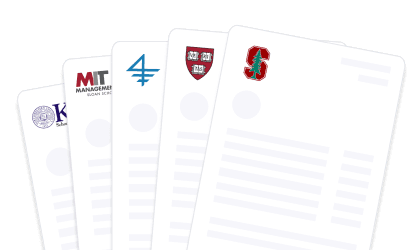5 Essential Tips for Improving Your MBA Resume
Matt P., an expert coach and Darden alumnus, provides several key tips for improving your MBA resume.

By Matt P.
Darden MBA | Expert in MBA Admissions | Let's Get You into Top B-Schools
Posted March 6, 2025

Free Event

Featuring Melanie E.
How to Get a Head Start on Your MBA Application
Starting Wednesday, April 16
10:00 PM UTC · 60 minutes

Featuring Melanie E.
The resume is a challenging, yet critical component of the MBA application. Distilling your professional experience, education, volunteer work, passions, and interests into one page can be intimidating and cumbersome for many.
The good news is that the resume doesn’t have to be! Many of the challenges with resume writing and editing boil down to style, formatting, and flow, which can be dramatically improved with a few simple tweaks. Here are some of my tips for improving your resume.
1. Make efficient use of space
Example: Developed a workforce optimization model in Excel to solve for a client’s annual turnover challenges resulting in an 80% adoption rate
Synthesizing all your accomplishments and leadership experience in a few bullets is often an act of balancing succinct writing with comprehensive context. Too often, I see bullet points like the one above. In this case, I want to focus on the two words on the second line: “adoption rate”. In terms of spacing, just those two words alone have consumed an entire line of real estate on the page. I recommend that a second line of text for a bullet point should consume at least 75% of page space for that line.
With just two words of text on an entire second line, this usually means the bullet can either be synthesized into one complete line of text, or there is room for expansion of the idea. In either scenario, you should always be asking yourself if there is room to consolidate language or expand upon your ideas when evaluating valuable page real estate.
2. Avoid detailing job duties
Example: Duties include raising funds to deliver a portfolio of new initiatives impacting our customer base
The resume is not the same thing as a job description. I’ve frequently seen bullet points like the one above where individuals simply list the day-to-day requirements of their role that can just as easily be lifted from a basic role description. Admissions committees want to understand your professional roles, but they are far more interested in YOUR specific contributions and leadership experience. Providing specific contextual examples about your efforts to raise funds or take meaningful action to drive portfolio delivery will give more insight into what you actually did versus what anyone with the same role title and obligations could do.
3. Consider using a “headline” for each role
Example:
Manager
Manager (promoted from Associate) in ABC’s Health Practice responsible for leading 4 engagements and over 25 staff within the practice’s M&A service offering
Building off of the previous tip, use of a “headline” (i.e. the italicized text above) can provide necessary context about your role versus valuable use of a bullet point. For each role on your resume, a headline can serve as a succinct opportunity to provide high-level, but relevant detail about your primary responsibilities and oversight in that capacity. The use of a headline will also save you time and page real estate in providing exhaustive background context for each of your supporting bullet points.
4. Give more context for your interests
Example: Passionate about coding; Enjoys Italian food
First, who doesn’t enjoy Italian food? At any rate, I’ve seen several resumes where the Skills and/or Interests section is left with generic, uninspiring details about what makes you unique. This section is just as valuable as the others in your resume when it comes to providing deeper insight and context into what makes you stand out.
If you are truly passionate about coding, provide details about what languages/programs you have proficiency in. Do you have a portfolio? Have you built a website or application using your passion? What do you enjoy about Italian food? Do you like to cook? What are some of your favorite recipes? Each interest on your resume should provide some context as to why that interest matters in your life and experience.
5. Avoid jargon/industry lingo
Example: Duties include leading multiple enterprise projects and teams to help deliver optimal strategic outcomes
I fell asleep after reading this bullet point. “Optimal strategic outcomes”? What does that even mean? Unfortunately, I have seen bullet points on resumes that are littered with acronyms, specific industry lingo, and other jargon that are impossible to decipher for those who do not have direct experience in the same industries.
For a standard job resume in your given field where specific acronyms and lingo may be appropriate, then inclusion may be necessary. For the MBA resume however, the objective is for you to demonstrate examples of leadership and driving action and/or results. This objective is best reached through clear and direct grammar and writing that accurately reflects your experience rather than requiring readers to google the four acronyms in each line of text.
Overall, there are numerous tips for improving each section of the resume, but I believe these five tips can be incorporated across the entire document to create a clear and complete summary of you. I also highly encourage asking a peer, friend, and/or coach to review your resume prior to submission specifically for these tips in mind. An extra set of eyes for detail and flow will always help the final product. Best of luck!
Matt P. is a UVA Darden MBA and expert storyteller. He has a critical eye for detail and quality and would love to help you get into your dream MBA program! Book a FREE intro call with Matt today!

Written by Matt
5.0
(35)
I have successfully coached many applicants at various stages of the MBA admissions process. Additionally, I was a Second Year Coach during my time at Darden where I coached several students as they navigated the hyper-competitive summer internship process with in-depth resume reviews, story crafting, and case interview prep. My attention to detail, hands-on support, and problem-solving background helped students land coveted internships with MBB and Fortune 500 organizations. Before pursuing an MBA, I was a consultant for healthcare and federal clients providing support with project and program management, data analytics and visualization, and operations management. Post-MBA, I continued my career in consulting focused on business transformation initiatives for clients in the retail, utilities, and biotech industries. Currently, I work for a behavioral health organization leading strategic business transformation efforts across multiple departments. I earned a B.A. in History from the College of William and Mary an MS in Commerce (concentration in Marketing & Management) from UVA, and an MBA from the Darden School of Business at UVA.
Matt has helped clients get into organizations like:
Stanford Graduate School of Business
Harvard Business School
The Wharton School (UPenn)
Kellogg School of Management (Northwestern)
University of California, Berkeley

















